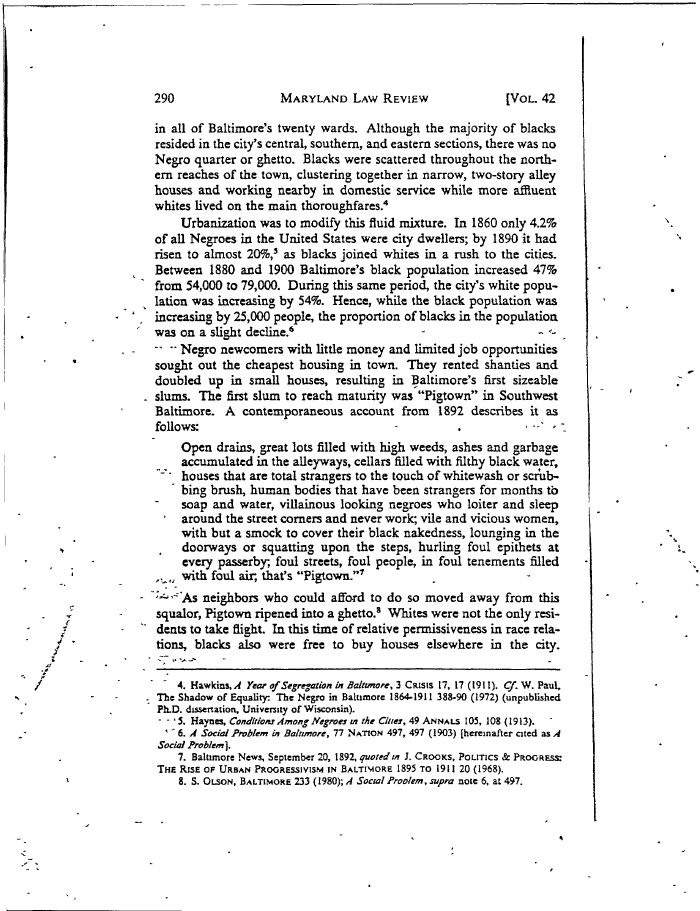 |
||||
|
Garrett Power, Apartheid Baltimore Style: The Residential Segregation Ordinances of 1910-1913, Maryland Law Review, 42 (1983) , Image No: 3 Enlarge and print image (63K) << PREVIOUS NEXT >> |
 |
||||
|
Garrett Power, Apartheid Baltimore Style: The Residential Segregation Ordinances of 1910-1913, Maryland Law Review, 42 (1983) , Image No: 3 Enlarge and print image (63K) << PREVIOUS NEXT >> |
| 290 MARYLAND LAW REVIEW [VOL. 42 in all of Baltimore's twenty wards. Although the majority of blacks resided in the city's central, southern, and eastern sections, there was no Negro quarter or ghetto. Blacks were scattered throughout the north- ern reaches of the town, clustering together in narrow, two-story alley houses and working nearby in domestic service while more affluent whites lived on the main thoroughfares.4 Urbanization was to modify this fluid mixture. In 1860 only 4.2% of all Negroes in the United States were city dwellers; by 1890 it had risen to almost 20%,3 as blacks joined whites hi a rush to the cities. from 54,000 to 79,000. During this same period, the city's white popu- lation was increasing by 54%. Hence, while the black population was increasing by 25,000 people, the proportion of blacks in the population was on a slight decline.6 Negro newcomers with little money and limited job opportunities sought out the cheapest housing in towni They rented shanties and doubled up in small houses, resulting in Baltimore's first sizeable slums. The first slum to reach maturity was "Pigtown" in Southwest Baltimore. A contemporaneous account from 1892 describes it as follows:. Open drains, great lots filled with high weeds, ashes and garbage accumulated in the alleyways, cellars filled with filthy black water, "houses that are total strangers to the touch of whitewash or scrub- bing brush, human bodies that have been strangers for months to soap and water, villainous looking negroes who loiter and sleep around the street comers and never work; vile and vicious women, with but a smock to cover their black nakedness, lounging in the doorways or squatting upon the steps, hurling foul epithets at every passerby, foul streets, foul people, in foul tenements filled .with foul air; that's "Pigtown."7 - As neighbors who could afford to do so moved away from this squalor, Pigtown ripened into a ghetto.8 Whites were not the only resi- dents to take flight. In this time of relative permissiveness in race rela- tions, blacks also were free to buy houses elsewhere in the city. 4. Hawkins,^ Year of Segregation in Baltimore, 3 CRISIS 17, 17 (1911). Cf. W. Paul. The Shadow of Equality: The Negro in Baltimore 1864-1911 388-90 (1972) (unpublished Ph.D. dissertation, University of Wisconsin). '5. Haynes, Conditions Among Negroes in the Cities, 49 ANNALS 105, 108 (1913). 6. A Social Problem in Baltimore, 77 NATION 497, 497 (1903) [hereinafter cited as A Social Problem]. 7. Baltimore News, September 20, 1892, quoted in J. CROOKS, POLITICS & PROGRESS: THE RISE OF URBAN PROGRESSIVE IN BALTIMORE 1895 TO 1911 20 (1968). 8. S. OLSON, BALTIMORE 233 (1980); A Social Problem, supra note 6, at 497. |